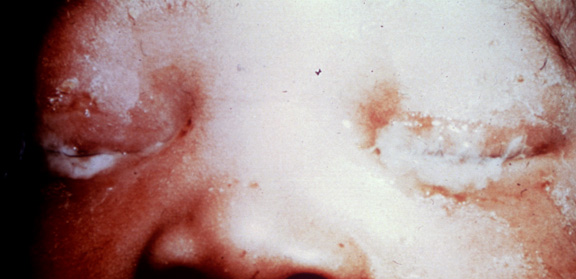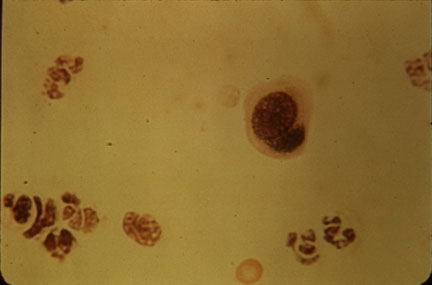Case Studies in Ophthalmology
Cases for the Ophthalmology Clerkship
Note to Medical Students on the Ophthalmology Rotation at the University of Iowa:
Print the question and answer sheet (Ctrl-Print or Command-Print) and enter your answers on it. You may prefer to type your answers on this page and then print it. If you do this, be careful that your full answer shows in the printout. Experience with Internet Explorer has been less than optimal.
Return the printed copy with your answers to Michelle Snyder or Dr. Kemp via campus mail (11290 PFP) or scan as a pdf and email to Michelle at michelle-r-snyder@uiowa.edu or Dr. Kemp at pavlina-kemp@uiowa.edu.
Case #48 Ophthalmia Neonatorium
History
Between the 5th and 6th postpartum days, this infant developed a purulent conjunctivitis with lid swelling.
Photo #1

A photomicrograph of a scraping of the patient’s conjunctival epithelium stained with Giemsa stain showed intracytomplasmic inclusions.
Photo #2

Enter Full Name (required):
Your email address (required):
Question #1
Discuss the historical significance of ophthalmia neonatorum.
Question #2
Discuss the more common as well as the most serious infectious causes of ophthalmia neonatorum.
Question #3
Discuss the reasons for making a specific etiologic diagnosis and the appropriate studies to do so.
Question #4
What is Crede prophylaxis and what are its short-comings?
Question #5
Discuss the appropriate treatment for the currently most common cause of ophthalmia neonatorum.
References
Raucher HS, Newton MJ: New issues in the prevention and treamentof ophthalmia neonatorum. Ann Ophthalmol 1983; 15:1004-1009.
Sandstrom KI et al: Microbial causes of neonatal conjunctivitis. J Pediatr 1984: 105:706-11.
Rapoza PA et al: Epidemiology of neonatal conjunctivitis. Ophthalmology 1986; 93:456-461.
Harrison HR: Chlamydial ophthalmia neonatorum. The dilemma of diagnosis and treatment. AJDC 1985; 139:550-551